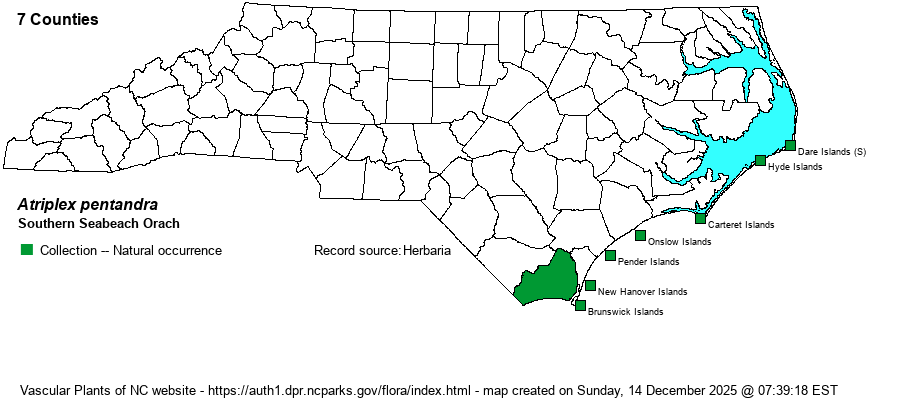| Author | (Jacquin) Standley | |
| Distribution | Outer Banks and southern outer Coastal Plain.
Maritime -- NC to FL and TX; W.I., S.A. | |
| Abundance | Uncommon to frequent; apparently more numerous than the extremely similar A. mucronata. | |
| Habitat | Upper portions of ocean beaches, among sparse grasses in low dunes, sandspits, bare spots in brackish marshes. Habitat differences between this species and A. mucronata do not seem to have been described. |
| Phenology | Flowering and fruiting July - November. | |
| Identification | Southern Seabeach Orach has wide-spreading branches that may be prostrate, ascending, or even erect. Leaves are alternate, narrowly elliptical to narrowly ovate. Small clusters (glomerules) of flowers grow in leaf axils and also terminally. From the very closely related A. mucronata, it can be told by its shorter bracts of the fruits (2.5-4.5 mm vs. 4.5-7 mm) and which are as wide or wider than long (vs. longer than wide). | |
| Taxonomic Comments | This species is very close to A. mucronata and authors in the past have treated the latter as part of A. pentandra, at various taxonomic ranks.
Members of the genus are most often found in saline to brackish sands. Male flowers usually produce petals, but females do not; in any event they are very small and not at all showy. Weakley's (2018) key must be used with care, and a dissecting scope is almost essential for successful identification. | |
| Other Common Name(s) | Crested Saltbush, Seabeach Orach. Both names are used for both of these two similar species; this website and Weakley (2018) use Southern Seabeach Orach for this species and Northern Seabeach Orach for A. mucronata. | |
| State Rank | S3 | |
| Global Rank | G5 | |
| State Status | | |
| US Status | | |
| USACE-agcp | | |
| USACE-emp | | |

